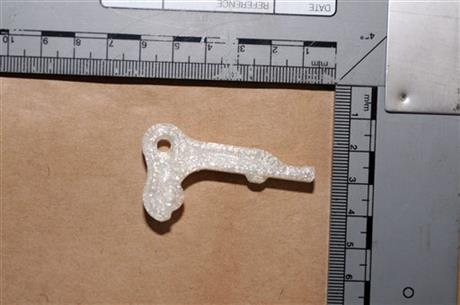
By JILL LAWLESS
ADDS POLICE STATEMENT INDICATING DOUBTS – Undated handout photo made available by Greater Manchester Police in northern England Friday Oct. 25, 2013 of a component made with a 3D printer which was found by officers during a raid on suspected gang members in the Bagley area of Manchester. Police initially claimed the item was part of a plastic printed firearm but later Friday issued a statement that they “cannot categorically say” it was a gun. (AP Photo/Greater Manchester Police)
LONDON (AP) — Police in northern England thought they’d made a major discovery, but they may have jumped the gun.
Officers said Friday they had seized what appeared to be gun components made on a 3-D printer — then, hours later, cast doubt on the find after technology experts said photos released by police appeared to be of parts for the printer itself.
The police department in greater Manchester initially said officers found what appeared to be a plastic magazine and trigger, along with a 3-D printer, in a raid targeting criminal gangs.
Forensic specialists were examining the parts “to establish if they could construct a genuine device,” police said.
If the gun was viable, it would be the first such seizure in Britain, police said. Authorities worry the technology could allow anyone to manufacture guns that would pass unnoticed through metal detectors
After some observers pointed out that the images released by police resembled printer parts, the police department toned down its language, saying detectives were attempting to “establish exactly what these parts can be used for and whether they pose any threat.”
“We need to be absolutely clear that at that this stage, we cannot categorically say we have recovered the component parts for a 3-D gun,” Assistant Chief Constable Steve Heywood said.
“What we have seized are items that need further forensic testing by national ballistics experts to establish whether they can be used in the construction of a genuine, viable firearm.”
A man was arrested for questioning and then released. He told Britain’s Press Association news agency that he owned the premises raided by police — a model shop — and used the 3-D printer to make plastic decorations and models. He said the suspected gun magazine was a spool holder and the “trigger” was another printer part.
Earlier this year, a Texas company said it had successfully test-fired a handgun created with a 3-D printer, and posted blueprints for the weapon online. Such printers can be paired with a home computer to manufacture objects using layers of high-density plastic.
Last month, London’s Victoria and Albert museum announced it had acquired two prototypes of the Texas gun for its collection of contemporary design.



